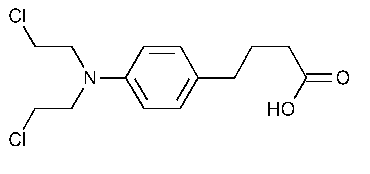Chlorambucil
Benzenebutanoic acid,4-[bis(2-chloroethyl)amino]-.
4-[p-[Bis(2-chloroethyl)amino]phenyl]butyric acid [305-03-3].
»Chlorambucil contains not less than 98.0percent and not more than 101.0percent of C14H19Cl2NO2,calculated on the anhydrous basis.
Packaging and storage—
Preserve in tight,light-resistant containers.
Identification—
A:
Infrared Absorption á197Sñ:1in 125solution,carbon disulfide,1-mm cell.
B:
Dissolve 50mg in 5mLof acetone,and dilute with water to 10mL.Add 1drop of 2Nsulfuric acid,then add 4drops of silver nitrate TS:no opalescence is observed immediately (absence of chloride ion).Warm the solution on a steam bath:opalescence develops (presence of ionizable chlorine).
Water,Method Iá921ñ:
not more than 0.5%.
Organic volatile impurities,Method Vá467ñ:
meets the requirements.
Solvent—
Use dimethyl sulfoxide.
Assay—
Dissolve about 200mg of Chlorambucil,accurately weighed,in 10mLof acetone,add 10mLof water,and titrate with 0.1Nsodium hydroxide VS,using phenolphthalein TSas the indicator.Each mLof 0.1Nsodium hydroxide is equivalent to 30.42mg of C14H19Cl2NO2.
Auxiliary Information—
Staff Liaison:Lawrence Evans,III,Ph.D.,Scientist
Expert Committee:(PA6)Pharmaceutical Analysis 6
USP28–NF23Page 426
Phone Number:1-301-816-8389
